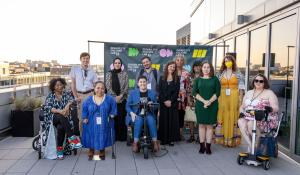
The European Union and other countries have banned over 1,600 chemicals from use in cosmetics. The US has banned 9. EU laws require that manufacturers prove chemicals are safe before they can be used in a product. In the US, chemicals are not always banned even if they potentially cause cancer; contain neuro- and immunotoxins; or contain hormone disruptors that could cause birth defects.
Cosmetics are very loosely defined by the FDA; the term encompasses perfume, moisturizer, makeup, nail polish, shampoo, hair dyes, toothpaste, and deodorant. Though the manufacturer is legally required to ensure the safety of a product, companies’ standards for safety may be quite different than what a customer might think—because many products still contain toxic substances like lead and formaldehyde.
According to the Environmental Working Group (EWG), women are exposed to 168 chemicals every day through cosmetics and personal care products, and those chemicals might be different each day, if you use multiple soaps or makeup items, for example. Men are exposed to 85 chemicals per day.
In its Skin Deep database, EWG clearly states that: “personal care products contain carcinogens, pesticides, reproductive toxins, endocrine disruptors, plasticizers, degreasers, and surfactants. They are the chemical industry in a bottle.”
Knowing that anything could be in your makeup drawer or bathroom counter is disturbing. Just because you’ve heard of an ingredient doesn’t make it safe. Baby powder, which often contains the carcinogenic mineral talc (you can buy a version that uses cornstarch), is the cause of 14,000 lawsuits adding up to an estimated $4 billion in fines against Johnson & Johnson for using the mineral in its products.
Unfortunately, vigilance is the only way to avoid toxic materials in your routine. In the Skin Deep database, you can search for cosmetics by name to see a list of ingredients and the toxicity of each, on a scale of one to ten. As of printing, the database includes 87,874 products. Head to EWG.org/skindeep to search your favorite products in the database.
I SMELL AN ISSUE
Scents are often a component of cosmetic products and are often included in menstrual products as well. Scent chemicals are called “fragrance” on an ingredients list, but that word can contain undisclosed chemicals of unknown toxicity and may contain allergens or chemicals linked to ailments such as allergic rash, endocrine disruption, and cancer, according to Women’s Voices for the Earth’s Chem Fatale Report.
MENSTRUAL PRODUCTS
If you use pads or tampons, you’ve probably seen commercials for all-natural organic versions. Gynecologists have tried to debunk these concerns (the chemicals involved in tampon production are trace), as a marketing ploy from companies that are greenwashing the products they sell.
Unfortunately, there are still causes for concern: namely products’ scents and plastic components. Pads and tampon applicators are made up of mostly plastic. Chemicals that may compose any given plastic, like BPA, BPS, phthalates, and DEHP, have been linked to reproductive system and liver damage. Organic cotton tampons are still better than conventional ones because of the benefits of growing cotton organically.
Luckily, there are options. Lunapads m sells washable cotton fabric pads, including the “Performa Super” pad, which can absorb the equivalent of four pads or tampons, according to the company. Lunapads also sells the DivaCup, which is a reusable menstrual cup that can be worn inside the body to replace tampons. They’re made from silicone, which unlike plastic, does not leach chemicals even when brought to a high temperature (such as boiling the product for cleaning), and resists the aging process of oxidative deterioration.
Choosing a reusable option, whether pad or cup, can save money on menstrual supplies. One cup costs $10-$40 and can last for years, compared to $7-$10 for a box of tampons or pack of pads which may last a month or two. If you’re not ready to switch to reusables, it isn’t hard to find tampons sold without an applicator, though finding plastic-free disposable pads is challenging.
There are many brands out there for applicator-free tampons, reusable pads, menstrual cups, and specially made absorbent underwear, which basically have built-in pads. You can find them wherever natural health products are sold, like from shops on GreenPages.org.
WHO IS MOST AFFECTED?
Women of color use more beauty products and are disproportionately exposed to harmful chemicals than white women, as published in a 2017 study in the American Journal of Obstetrics and Gynecology.
In 2016, Skin Deep analyzed 1,177 beauty products marketed to Black women and found one in 12 was ranked highly hazardous. Less than 25 percent scored low in potentially hazardous ingredients.
Ami Zota, a professor at George Washington University’s School of Public Health, has theorized that Black, Latinx, and Asian American women use more beauty products to meet societal pressure. They may also be exposed to more chemicals in harmful products because there are fewer natural products marketed to them, compared to white women.
The Green Business Network has certified many brands that focus on natural, nontoxic products, including those that are owned by women and women of color, which can be found at GreenPages.org.
Research suggests the market is ready for more natural products aimed towards women of color. Black women are estimated to spend 80 percent more per year on skin care than non-Black women, and that difference is estimated because Black women must sample many more products to find those that work.
“African American and Latina women want to be like everyone else and are buying what’s within their reach,” says Sylvia Walker, owner of NAIWBE, Natural As I Wanna Be.
Walker is a Registered Nurse and Certified Health Coach who started NAIWBE when she got frustrated by the effects harsh hospital cleansers and lotions had on her skin. She provides demonstrations of NAIWBE products and education on healthy lifestyle choices in Sam’s Club, one of the places she sells products. She loves to answer questions about what’s in the products customers are using and what they could be getting from natural products.
“Everyone wants to look good and feel food, and fit in,” says Walker. “A lot of people are more open today to speaking with their doctors, than 10 or 15 years ago. Because of the internet people read more, people ask more questions… instead of just buying based on marketing and TV ads with beautiful women.”
Updated March 2023.







